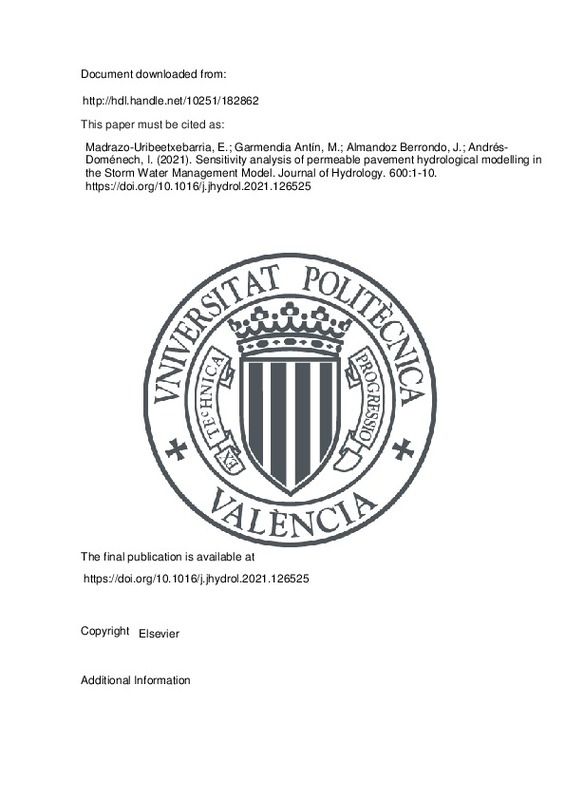JavaScript is disabled for your browser. Some features of this site may not work without it.
Buscar en RiuNet
Listar
Mi cuenta
Estadísticas
Ayuda RiuNet
Admin. UPV
Sensitivity analysis of permeable pavement hydrological modelling in the Storm Water Management Model
Mostrar el registro sencillo del ítem
Ficheros en el ítem
| dc.contributor.author | Madrazo-Uribeetxebarria, Eneko
|
es_ES |
| dc.contributor.author | Garmendia Antín, Maddi
|
es_ES |
| dc.contributor.author | Almandoz Berrondo, Jabier
|
es_ES |
| dc.contributor.author | Andrés-Doménech, Ignacio
|
es_ES |
| dc.date.accessioned | 2022-05-24T18:04:47Z | |
| dc.date.available | 2022-05-24T18:04:47Z | |
| dc.date.issued | 2021-09 | es_ES |
| dc.identifier.issn | 0022-1694 | es_ES |
| dc.identifier.uri | http://hdl.handle.net/10251/182862 | |
| dc.description.abstract | [EN] The Storm Water Management Model (SWMM), widely used by engineers to design or analyse stormwater networks, allows to model the so-called Low Impact Development (LID) controls, which reduce the flow conveyed to traditional networks. But, values for LID control parameters are often unknown. Furthermore, it is not always easy to link the cross-section materials to those provided by the model, particularly in the soil layer. This article provides a global sensitivity analysis for the PP type of LID control, in order to support practitioners in calibration tasks. The analysis explores what factors are the most influential and which can be fixed while calibrating a model. In particular, flow volume and peak are studied but the analysis also explores the influence of storm length and drain layer, which is optional. At the end, the most influential parameters, and those that can be neglected are presented, showing that we can focus on quite less parameters than initially given when calibrating a PP model in SWMM. | es_ES |
| dc.description.sponsorship | This research was funded by the University of the Basque Country UPV/EHU (US19/17). It also was supported by Donostia/San Sebastian City Council, which we would like to thank for the invaluable assistance provided during the project of which this study is only a first step | es_ES |
| dc.language | Inglés | es_ES |
| dc.publisher | Elsevier | es_ES |
| dc.relation.ispartof | Journal of Hydrology | es_ES |
| dc.rights | Reconocimiento - No comercial - Sin obra derivada (by-nc-nd) | es_ES |
| dc.subject | Permeable pavement | es_ES |
| dc.subject | SWMM | es_ES |
| dc.subject | Low impact development | es_ES |
| dc.subject | SUDS | es_ES |
| dc.subject | Sensitivity analysis, Calibration | es_ES |
| dc.subject.classification | INGENIERIA HIDRAULICA | es_ES |
| dc.title | Sensitivity analysis of permeable pavement hydrological modelling in the Storm Water Management Model | es_ES |
| dc.type | Artículo | es_ES |
| dc.identifier.doi | 10.1016/j.jhydrol.2021.126525 | es_ES |
| dc.relation.projectID | info:eu-repo/grantAgreement/Universidad del País Vasco/Euskal Herriko Unibertsitatea//US19%2F17//Calibración y validación de un modelo matemático para el análisis de la respuesta hidráulica y de retención de contaminantes de pavimentos permeables a partir de la monitorización de una zona experimental en Txomin-Enea (Donostia-San Sebastian) / | es_ES |
| dc.rights.accessRights | Abierto | es_ES |
| dc.contributor.affiliation | Universitat Politècnica de València. Departamento de Ingeniería Hidráulica y Medio Ambiente - Departament d'Enginyeria Hidràulica i Medi Ambient | es_ES |
| dc.description.bibliographicCitation | Madrazo-Uribeetxebarria, E.; Garmendia Antín, M.; Almandoz Berrondo, J.; Andrés-Doménech, I. (2021). Sensitivity analysis of permeable pavement hydrological modelling in the Storm Water Management Model. Journal of Hydrology. 600:1-10. https://doi.org/10.1016/j.jhydrol.2021.126525 | es_ES |
| dc.description.accrualMethod | S | es_ES |
| dc.relation.publisherversion | https://doi.org/10.1016/j.jhydrol.2021.126525 | es_ES |
| dc.description.upvformatpinicio | 1 | es_ES |
| dc.description.upvformatpfin | 10 | es_ES |
| dc.type.version | info:eu-repo/semantics/publishedVersion | es_ES |
| dc.description.volume | 600 | es_ES |
| dc.relation.pasarela | S\440616 | es_ES |
| dc.contributor.funder | Universidad del País Vasco/Euskal Herriko Unibertsitatea | es_ES |
| dc.subject.ods | 06.- Garantizar la disponibilidad y la gestión sostenible del agua y el saneamiento para todos | es_ES |
| dc.subject.ods | 09.- Desarrollar infraestructuras resilientes, promover la industrialización inclusiva y sostenible, y fomentar la innovación | es_ES |
| dc.subject.ods | 11.- Conseguir que las ciudades y los asentamientos humanos sean inclusivos, seguros, resilientes y sostenibles | es_ES |
| dc.subject.ods | 13.- Tomar medidas urgentes para combatir el cambio climático y sus efectos | es_ES |







![[Cerrado]](/themes/UPV/images/candado.png)

